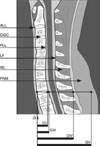Abstract
Purpose
To diagnose the extent of soft tissue damage with MRI, and to evaluate the relationship between soft tissue damage and a spinal cord injury in an extension injury to the lower cervical spine trauma.
Materials and Methods
Eighty-one patients who treated surgically for an anextension injury to the cervical spine over the past 5 years, were analyzed. All patients had undergone MRI after the injury, and for the specific grading of soft tissue damage, the grades were defined from grades 1 to 5.
Results
The spinal cord injury developed with more than grade 3 soft tissue damage associated with a rupture of the posterior longitudinal ligament (p<0.01). The changes in signal intensity of the spinal cord also developed according to the severity of soft tissue damage (p<0.01). There was no relationship between the soft tissue damage and the spinal cord injury in spinal stenosis (p=0.75).
Figures and Tables
 | Fig. 2Grade I soft tissue damage according to the MRI finding. Rupture of ALL C6-7 and an avulsion fracture of the superior end plate of C7 (①). |
 | Fig. 3Grade II soft tissue damage according to the MRI finding. Rupture of the ALL (①) and posterior extrusion of the disc material (②) of C5-6 and 6-7. |
 | Fig. 4Grade III soft tissue damage according to the MRI finding. Rupture of ALL (①), posterior extrusion of disc material (②) and rupture of the PLL (③) of C4-5, C5-6 and C6-7. |
 | Fig. 5Grade IV soft tissue damage according to the MRI finding. Rupture of the ALL (①), posterior extrusion of disc material (②), rupture of the PLL (③) and rupture of the ligamentum flavum and interspinous ligament (④) of C5-6. |
 | Fig. 6Grade V soft tissue damage according to the MRI finding. Rupture of the ALL (①), posterior extrusion of disc material (②), rupture of the PLL (③), rupture of the ligamentum flavum and interspinous ligament (④), and rupture of the posterior neck muscle (⑤) of C3-4 and C4-5. |
References
1. Akaishi F. Biomechanical properties of the anterior and posterior longitudinal ligament in the cervical spine. Nippon Ika Daigaku Zasshi. 1995. 62:360–368.

2. Albrecht RM, Malik S, Kingsley DD, Hart B. Severity of cervical spine ligamentous injury correlates with mechanism of injury, not with severity of blunt head trauma. Am Surg. 2003. 69:261–265.
3. Allen BL, Ferguson RL, Lehmann TR, O'Brien RP. A mechanistic classification of closed, indirect fractures and dislocations of the lower cervical spine. Spine. 1982. 7:1–27.

5. Bedbrook GM. Pathological principles of the management of spinal cord trauma. Paraplegia. 1966. 4:43–56.
6. Bohlman HH. Acute fractures and dislocations of the cervical spine. An analysis of three hundred hospitalized patients and review of the literature. J Bone Joint Surg Am. 1979. 61:1119–1142.

7. Borovich B, Peyser E, Gruskiewicz J. Acute central and intermediate cervical cord injury. Neurochirurgia (Stuttg). 1978. 21:77–84.

8. Castellano V, Bocconi FL. Injuries of the cervical spine with spinal cord involvement (myelic fractures): statistical considerations. Bull Hosp Joint Dis. 1970. 31:188–194.
9. Denis F. Spinal instability as defined by the three-column spinal concept in acute spinal trauma. Clin Orthop Relat Res. 1984. 189:65–76.
10. Donovan WH, Kopaniky D, Stolzmann E, Carter RE. The neurological and skeletal outcome in patients with closed cervical spinal cord injury. J Neurosurg. 1987. 66:690–694.

12. Flanders AE, Schaefer DM, Doan HT, Mishkin MM, Gonzalez CF, Northrup BE. Acute cervical spine trauma: correlation of MR imaging findings with degree of neurologic deficit. Radiology. 1990. 177:25–33.

13. Flanders AE, Spettell CM, Friedman DP, Marino RJ, Herbison GJ. The relationship between the functional abilities of patients with cervical spinal cord injury and the severity of damage revealed by MR imaging. Am J Neuroradiol. 1999. 20:926–934.
15. Hohl M. Soft-tissue injuries of the neck in automobile accidents. Factors influencing prognosis. J Bone Joint Surg Am. 1974. 56:1675–1682.
16. Holdsworth F. Fractures, dislocations, and fracture- dislocations of the spine. J Bone Joint Surg Am. 1970. 52:1534–1551.
17. Kahn EA, Schneider RC. Chronic neurological sequelae of acute trauma to the spine and spinal cord. I. The significance of the acute-flexion or tear-drop fracture-dislocation of the cervical spine. J Bone Joint Surg Am. 1956. 38:985–997.
18. Katzberg RW, Benedetti PF, Drake CM, et al. Acute cervical spine injuries: prospective MR imaging assessment at a level 1 trauma center. Radiology. 1999. 213:203–212.

19. Marar BC. Hyperextension injuries of the cervical spine. The pathogenesis of damage to the spinal cord. J Bone Joint Surg Am. 1974. 56:1655–1662.
20. McAfee PC, Cunningham B, Dmitriev A, et al. Cervical disc replacement-porous coated motion prosthesis: a comparative biomechanical analysis showing the key role of the posterior longitudinal ligament. Spine. 2003. 28:S176–S185.
21. Pavlov H, Torg JS, Robie B, Jahre C. Cervical spinal stenosis: determination with vertebral body ratio method. Radiology. 1987. 164:771–775.

22. Selden NR, Quint DJ, Patel N, d'Arcy HS, Papadopoulos SM. Emergency magnetic resonance imaging of cervical spinal cord injuries: clinical correlation and prognosis. Neurosurgery. 1999. 44:785–792.

24. Song KJ, Bae HK, Koh DH. Diagnosis in extension injuries of the lower cervical spine. J Korean Orthop Assoc. 2003. 38:172–178.

25. Song KJ, Lee KB. The prognosis of the acute cervical spinal cord injury. J Korean Orthop Assoc. 1998. 33:794–801.

26. Song KJ, Shin PS. Surgical treatment of lower cervical spine injury. J Korean Orthop Assoc. 1999. 34:117–126.

27. Stauffer ES, MacMillan M. Rockwood CA, Green DP, Bucholz RW, Heckman JD, editors. Fractures and dislocations of the cervical spine. Rockwood and Greens fractures in adults. 1996. 4th ed. Philadelphia: Lippincott-Raven Publishers;1475–1477.
28. Taylor AR, Blackwood W. Paraplegia in hyperextension cervical injuries with normal radiographic appearances. J Bone Joint Surg Br. 1948. 30:245–248.





 PDF
PDF ePub
ePub Citation
Citation Print
Print









 XML Download
XML Download